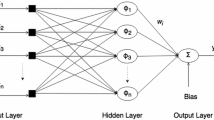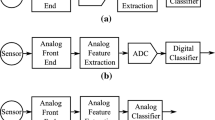Abstract
In this paper we describe a new Self-Adaptive Re-Configurable Terminal, based on blind recognition of the system in use. This new terminal is operates thanks to a new radio interface receiver concept comprising two functional phases. These two phases are mapped on a specific architecture previously presented in [1]. The first one is devoted to a Wide Band Analysis (Wba) of the received signal in order to find which standard is being used. The second one being the demodulation itself. In this paper we focus on thisWba. It includes an iterative process in order to find the right bandwidth which has to be compatible with the Signal Processing techniques we use. During the last step of the process, blind standard recognition is performed by means of Radial Basis Function Neural Networks, which allow making full use of the analogy between our problem and conventional pattern recognition problems. Extensive simulation with true data of signals received in our lab has been performed and confirms the interest and efficiency of this type of recognition.
Résumé
Un terminal reconfigurable de manière auto-adaptative est décrit dans cet article. Ce terminal fonctionne grâce à un nouveau concept d’interface radio comprenant deux phases fonctionnelles distinctes. Cette interface s’appuie elle-même sur une architecture présentée précédemment dans [1]. La première phase fonctionnelle correspond à une analyse à large bande du signal RF reçu. La seconde étant la démodulation elle-même. Nous nous intéressons dans cet article à la première phase fonctionnelle d’analyse à large bande (Alb). Cette analyse comprend, en premier lieu, une adaptation itérative de la largeur de bande du signal RF compatible avec le pouvoir de résolution des techniques d’analyse spectrale utilisées. Cette analyse se poursuit par la reconnaissance autodidacte des normes des signaux reçus au moyen de réseaux neuronaux utilisant des fonctions de base radiale, qui permettent de profiter au maximum de l’analogie entre notre problème et les problèmes de reconnaissance de formes. De nombreuses simulations avec des signaux réels reçus au laboratoire confirment l’intérêt et la performance de ce type de reconnaissance.
Similar content being viewed by others
References
Roland (C.), Palicot (J.), “A Two Step Architecture for an Adaptive Receiver”3G2000 conference 27–29 March 2000, Londres, UK.
Upmal et Lackey, «Speakeasy, the Military Software »,Ieee Communications Magazine (Ny: ieee Press), 1995.
Mitola (J.), « Software Radios: Survey, Critical Evaluation and Future Directions »,Proceedings of the National Telesystems Conference,Ny: ieee Press, May 1992.
Mitola (J.), « The software Radio Architecture »,Ieee Communications Magazine, May 95, pp. 26–38.
http://www.wireless-world-research.org/
http://www.gnu.org/software/gnuradio/
Mitola (J.), « Cognitive Radio », PhD Dissertation au Royal Institute of Technology, May 2000, Sweden.
Roland (C.), « Étude d’un récepteur universel auto-adaptatif pour les transmissions sans fil », Thèse soutenue le 9 octobre 2001 au Conservatoire des Arts et Métiers, en Systèmes Physiques et Métrologie, Paris.
Moessner (K.), Tafazolli (R.), « Terminal Recongurability — The Software Download Aspect »,3G2000, London, 27–29 March 2000.
Hentschel (T.), Fettweis (G.), Bronzel (M.), « Channelization and Sample Rate Adaptation in Software Radio Terminals », ACTS, Mobile Communications Summit, Rhodes, June 8–11, 1998.
Hentschel (T.), (Dresden University of Technology), sort, Contribution: sort/wp3100/tud/002.
TRUST, IST-1999-12070, D3.1.1, « Proposal and initial investigation of certain know and augmented analogue signal processing techniques for future flexible transceiver architectures », 29 Sept. 2000.
Akmouche (W.), « Discrimination des modulations monoporteuses et multiporteuses par un test de normalité basé sur les cumulants d’ordre 4 »,17 e Colloque GRETSI, Vannes, 13–17 septembre 1999.
Marchand (P.), « Détection et reconnaissance de modulations numériques à l’aide des satistiques cycliques d’ordre supérieur » - Thèse soutenue le 25 octobre 98 à I’INPG.
Gournay (P.), Nicolas (P.), « Analyse spectrale cyclique et analyse temps-fréquence pour l’identification automatique de transmission », 15e Colloque GRETSI, Juan les Pins, 18–21 septembre 1995.
Davy (M.), Doncarli (C), Tourneret (J.Y.), « Supervised Classification Using mcmc Methods »,Icassp’00.
Azzouz (E.E.), Nandi (A.K.), « Automatic Modulation Recognition of Communication Signals »,Kluwer Academic Publishers, 1996.
Boudier (C), Burel (G.), Azou (S.), « Analyse automatique d’une transmission numérique », 17e Colloque GRETSI, Vannes, 13–17 septembre 1999.
Grossekatthoefer (A.), « Classification of Analog and Digital Modulation Types based on Artificial Neural Networks »,Ict’98, Porto Carras, June 21–29, 1998.
Roland (C), Palicot (J.), « Un terminal multistandard utilisant le gps pour se configurer »,Isivc 2000, Rabat, 17–20 April 2000.
Amoroso (F), « The Bandwith of the Digital Data Signal »,Ieee Communications Magazine, vol. 18, November 80, pp. 13–24.
Kay (S.), « Modem Spectral Estimation-Theory and applications », Prentice-Hall, 1987.
Broomhead (D.S.), Love (D.), « Multivariable Functional Interpolation and Adaptive Networks », Complex Systems, Volume 2, pp. 321–355, 1988.
Ciochocki (A.), Unbehauen (R.), « Neural Networks for Optimization and Signal Processing », Wiley and Sons, New York, 1993.
Jodouin (J.F.), « Les réseaux neuromimétiques », Hermès, Collection informatique, Paris, 1994.
Park (J.), Sanderg (I.W.), « Approximation and Radial Basic Function Networks », Neural Computation, Volume 5, pp. 305–316, 1993.
Author information
Authors and Affiliations
Corresponding authors
Rights and permissions
About this article
Cite this article
Roland, C., Palicot, J. A self-adaptive universal receiver. Ann. Télécommun. 57, 421–456 (2002). https://doi.org/10.1007/BF02995170
Received:
Accepted:
Issue Date:
DOI: https://doi.org/10.1007/BF02995170
Key words
- Radiocommunication
- Mobile station
- Adaptive system
- Reconfigurable circuit
- Software radio
- System architecture
- Spectral analysis
- Power spectrum
- Neural network
- Error function
- GSM
- Automatic recognition
- Pattern recognition




